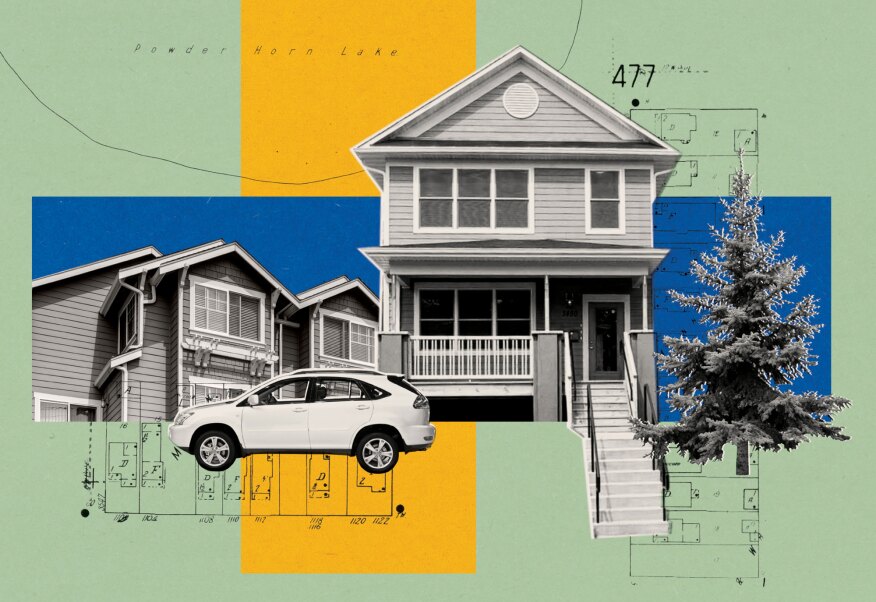By Matthew Gardner
Chief Economist
Windermere Real Estate
On April 8, 2023, the Washington State House of Representatives passed HB 1110, which is legislation that would allow the development of attached housing products, including duplexes, triplexes, fourplexes up to sixplexes, townhomes, and stacked flats on land currently designated for the development of single-family detached housing.
Land zoning is certainly nothing new. In fact, the Seattle City Council passed its first zoning ordinance, called the Comprehensive Plan, back in July of 1923[i]. Prior to this plan, Seattle’s land use code allowed for multifamily dwellings and detached houses everywhere framed buildings were allowed[ii].
The topic of residential zoning is unarguably polarizing and, as I have been quoted as saying many times before, “liberalism ends at the driveway.” Having read some of the recent editorials and articles on the topic of residential zoning, I understand why it has many people up in arms.
However, this legislation (HB 1110), and its companion bill (SB 5190) are not unique to Seattle or Washington State as a whole.
Allowing Housing Density in Single-Family Neighborhoods is Nothing New
The move to add density in traditional single-family neighborhoods has its genesis in Minneapolis, Minnesota where, in 2018, a group known as Neighbors for More Neighbors were at the heart of what became one of the biggest land use stories in recent years with their proposal to legalize duplexes and triplexes wherever single-family housing was allowed.
In 2019, Governor Brown of Oregon signed into law HB 2001, which allows duplexes, triplexes, fourplexes, and cottage clusters to be built on land zoned for single-family homes in cities with over 25,000 residents. In cities with over 10,000 residents, duplexes were allowed on land zoned for single-family homes.
More recently, Governor Newsom of California signed into law Senate Bill 9 which went into effect statewide on January 1, 2022. This legislation required all California cities to allow for the development of up to four homes on a single lot.
What has Happened Since Zoning Changes Have Been Implemented?
The answer to this is not much.
In Minneapolis, the city has, so far, permitted 64 duplexes and 21 triplexes.[iii] Worth noting is that half of the duplex permits are on lots unaffected by the zoning change.
In Oregon, it’s still too early to say what the impact of zoning changes are, primarily because the legislation was phased in, starting with Oregon’s medium-sized cities, which began allowing duplex development inside single-family zoned areas on June 30, 2021. Then on June 20, 2022, attached housing started to be allowed in cities within the Portland Metro region and the state’s other largest dozen cities.
In 2021, Oregon’s medium-sized cities issued 212 duplex permits and, in 2022, 194 duplex permits, and permits for just 42 triplex and fourplex permits were issued. Hardly a boom!
Meanwhile, in California, the impact of SB-9 has also been minimal with some of the state’s largest cities reporting that they have received just a handful of applications for either lot splits or new units, while other cities reported none[iv].
But There has Been Considerable Pushback
At the same time that these zoning policies were being put in place, lawyers were also busy trying to put a stop to them.
Smart Growth Minneapolis, the Audubon Society of Minneapolis, and Minnesota Citizens for the Protection of Migratory Birds has sued to force the city to conduct an environmental review, alleging that “a plan allowing the increase in density would likely pollute natural resources because of the increase in hard surfaces, soil erosion and increased runoff, among other adverse effects.”[v]
In Oregon and California, I am not aware of any pending legislation to fight the zoning changes that have been made but would not be surprised to see them at some point.
So, What’s the Bottom Line?
As I have shown above, not much has happened in the states where legislation has passed to increase density, and I can’t say that I am surprised.
The change was incremental in Minneapolis, which makes a lot of sense to me. For most homeowners, the thought of going through the process themselves to rezone the land their home sits on is daunting. Developers are unarguably better positioned to purchase several houses in order to rezone and achieve some economies of scale; however, it’s an arduous process to simultaneously negotiate with several homeowners and not likely to become a common practice.
Moreover, the likelihood of a wave of development activity is unlikely simply because it would be very hard for a developer to make a new project financially viable given the cost to acquire and raze the homes in the first place, followed by the cost to build new units.
It’s also worth mentioning that there are some opponents who believe that builders would be allowed to ignore development standards that are in place, and that would also be factually inaccurate because HB 1110 expressly permits cities to impose objective building and development standards to protect public health and safety and the environment.
And For Washington State?
Washington officials project that the state will need roughly one million new homes[vi] by 2044. The pro-housing nonprofit group Up for Growth estimates the state’s shortage of homes rose from 64,000 in 2012 to 140,000 in 2019 – more than doubling in just seven years.
Compared with typical apartment buildings, middle housing yields fewer homes per lot, but there’s power in numbers: Washington has about 1.8 million detached houses occupying roughly three-quarters of the state’s residential land. If middle housing were legalized, only a fraction of those house lots would gain new homes[vii], but that small share would still be enough to help pull Washington out of its housing shortage.
Reading between the lines, I believe that Washington State has moved in this direction not just because of the numbers I show above but because it knows that many areas are already not in compliance with the 1990 Growth Management Act, which requires enough land for the development of housing units that meet the long-term population and household projections produced by the States Office of Financial Management.
Although, technically, no jurisdiction is currently out of compliance, it is my belief that the reality is different, and that cities are including land as developable that would never be built on for reasons ranging from proximity and infrastructure to topography.
At some point, the methodology for calculating land supply will be rewritten, and a far truer picture will emerge. What I find ironic about this is that when cities are found to be out of compliance with the GMA, they are then required to undertake “reasonable measures” to increase density to meet their goals.
Essentially, this means enacting the same legislation that has just passed.
Finally, I do take issue with some of the dramatic bylines that suggest that single-family zoning is going to be “eliminated” or “banned” because that is not accurate.
Our government is not removing our ability to build single-family housing if we wish to do so. All they are saying is that you can now build more housing units if it makes more sense to do so.
I believe this is a net positive for our state, and certainly nothing to be concerned about. After all, as people involved in the real estate industry, shouldn’t we be encouraging home ownership, especially for our younger residents who are having an increasingly challenging time getting their foot on the first rung of the housing ladder?
i https://15kwhm2a.medium.com/a-
ii https://15kwhm2a.medium.
iii https://www.builderonline.
iv https://ternercenter.
v https://
vi https://ofm.wa.gov/sites/
vii https://upforgrowth.org/

 Facebook
Facebook
 X
X
 Pinterest
Pinterest
 Copy Link
Copy Link


